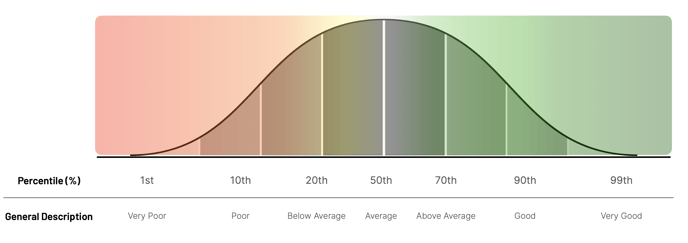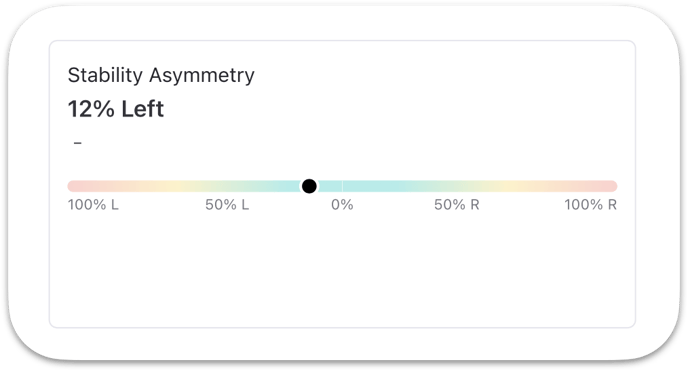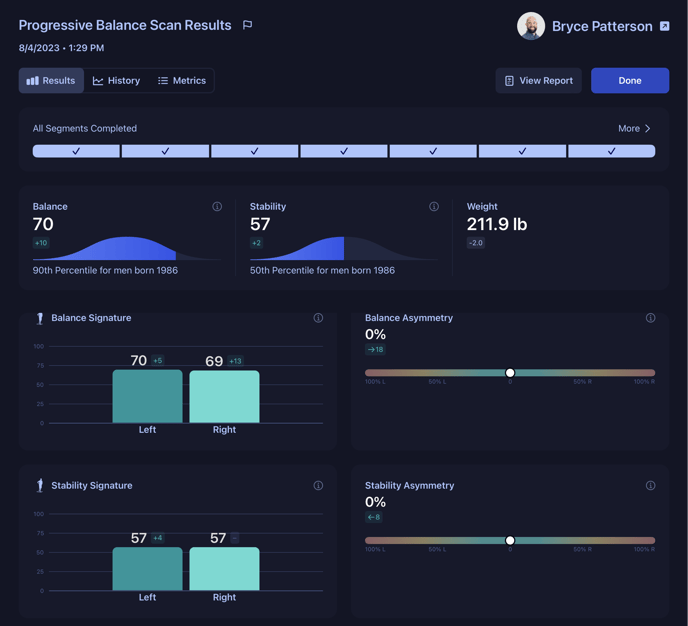This article provides an in-depth overview of key considerations and recommendations for utilizing and interpreting the Balance Scan.
Overview
A simple progressive assessment guides users through a series of progressively more difficult balance challenges to assess stability, asymmetry, unilateral balance, and proprioception.
Balance tests are one of the most utilized and well-researched assessments to measure stability, asymmetry, unilateral balance, and proprioception. Neural and vestibular systems also contribute highly to the balance system, making balance assessment an important vital sign for holistic health.
Balance capability has been correlated to everything from fall risk to joint pain and respiratory disease and provides a simple, reliable assessment with a variety of applications:
Progressive Balance Scan Utility
- Baseline Balance or Proprioceptive Assessment
- Physical Therapy/Rehabilitation Testing
- Fall Risk Assessment
- Fatigue/Readiness Assessment
- Balance/Gait Disorder Evaluation
- Neurological/Vestibular Disorder Evaluation
- Traumatic Brain Injury (TBI) Evaluation
- Performance/Risk Identification
When to Utilize the Balance Scan
- Baseline concussion testing
- Fatigue/readiness monitoring
- Joint replacement (total hip and knee)
- Lower extremity injury
- Concussion/TBI
- Chronic spine/low back pathology
- Vestibular dysfunction
- Neurological dysfunction
- Falls risk assessment
- Diabetes/peripheral neuropathy
- Developmental delay
Balance Scan Protocol
The Progressive Balance Scan consists of a series of progressively more difficult balance challenges and includes the following components:
Stability - a dynamic weight shift to each side, keeping both feet on the ground to assess the most fundamental capabilities of balance.
Balance - a dynamic weight shift and single-leg balance to assess more advanced functional capabilities of balance
Note: The Balance and Stability components of the Progressive Scan, in some cases, can also be utilized independently of the Progressive Balance Scan protocol.
- Find and select a user, click on Balance, and click Start Scan
- Follow the prompts on the screen:
- Step on the plate and stand still
- When prompted, shift your weight to your RIGHT until the dot on the screen is within the highlighted area, and hold
- At the tone, return your weight to the center and stand still
- When prompted, shift your weight to your LEFT until the dot on the screen is within the highlighted area, and hold
- At the tone, return your weight to the center and stand still
- When prompted, lift your left leg to balance on the RIGHT for 8-10 seconds
- Return your left foot to the plate and stand still
- When prompted, repeat the above steps on the LEFT side
- Continue following prompts for a total of two balance trials on each side
- If a Balance task cannot be completed successfully, click “Skip Segment” or “Skip All” to complete the scan
- We recommend skipping a segment if the user fails three attempts.
Feel free to download and print the Balance Scanning Instructions PDF
Check out the Scan Protocols article for more in-depth guidance, including a video.
Primary Balance Scan Biomarkers
Stability and Balance
Stability and Balance are derived from their Progressive Balance Scan components and represent more fundamental and advanced balance capabilities respectively. Higher scores indicate better balance capabilities.
Signature Scores: Left and Right
The Left and Right scores represent an individual’s ability to minimize motion on their left and right sides during each component of the scan.
The more steady an individual remains, the higher score they'll receive; the more an individual moves, the lower score they'll receive. These scores are most influenced by Sway.
Asymmetry Scores
The Asymmetry scores quantify differences in balance capabilities from side to side based on the Left and Right Signature Scores. Higher values indicate greater asymmetry.
Normalized Results Interpretation
Stability and Balance (Left and Right)
Balance and Stability, and their Signature scores for each side, are all contextualized into T-score values, where 50 is equal to the mean or average. Higher scores indicate better balance capabilities. Anything higher than 50 is above average, and anything lower than 50 is below average.
Typical scores for the cohort or population range from 40-60, meaning the majority of users in that group score within a 10-score range (1 standard deviation) from the average of 50.

Typical scores for the cohort or population range from 40-60.
Approximately a 5-point change in Balance is considered significant and highlighted within the software.
Balance and Stability are also represented as percentiles to improve interpretation. A score of 50 is equivalent to the 50th percentile (average), while a score of 60 is equivalent to the 84th percentile (above average). See the image below for a visual representation of these scores.

Asymmetry
Asymmetry scores are based upon the Left and Right signature scores, then are all contextualized into normalized symmetry percentages, where 0% represents maximum symmetry. Higher scores indicate greater asymmetry between limbs. Scores also include an L or R to represent which side has the higher score.
Typical scores range from 0-20% on either side, meaning the majority of users score within a 20% range (1 standard deviation) from 0. Small variations within this range on either side are common in people subjected to repeated testing and are typically not significant. Scores greater than 20% on either side can be considered atypical.

Typical scores range from 0-20% on either side.
Scores greater than 20% on either side can be considered atypical.
Explaining the Results
Balance is an important vital sign, and though most commonly used for specific use cases such as injury rehabilitation and fall risk assessment, the utility of balance assessment encompasses all of Movement Health.
What?
“The Progressive Balance Scan measures how steady you can stand and how well you remain steady on one leg. The more steady you remain, the higher score you’ll receive. The more movement, the lower your score will be.”
How?
“The force plate is accurately measuring your balance, while the software analyzes and compares the data to the population to provide insights into your balance capability. This allows us to understand how your balance compares to people similar to you.”
Why?
“The information this provides allows us to identify how your balance compares to others; for example, is it at, above, or below average? Additionally, this allows us to longitudinally track your balance over time and monitor any progression or regression.”
Additional Resources
- Balance Testing - Literature and Rationale
- White Paper: Balance Assessment Overview
- Scan Protocols
- The Balance Scan
- What is being measured during the Balance Scan?
- Normative Data in the Sparta Movement Health Platform
- Movement Panel Metrics (additional raw and normalized metrics)
- Sparta Science Academy - Free Online Training




